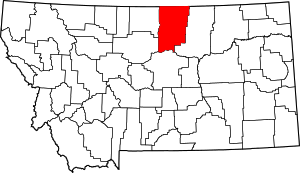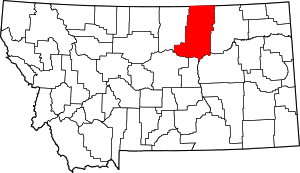Fort Belknap Indian Reservation
The Fort Belknap Indian Reservation (Gros Ventre: ʔakθɔ́ɔyɔ́ɔ, lit. 'the fence' or ʔɔʔɔ́ɔ́ɔ́nííítaanʔɔ, 'Gros Ventre tribe'[3]) is shared by two Native American tribes, the A'aninin (Gros Ventre) and the Nakoda (Assiniboine). The reservation covers 1,014.064 square miles (2,626.41 km2), and is located in north central Montana. The total area includes the main portion of their homeland, as well as off-reservation trust land. The tribes reported a total of 2,851 enrolled members in 2010. The capital and largest city is Fort Belknap Agency, at the reservation's north end. This is just south of the city of Harlem across the Milk River.
Fort Belknap Indian Reservation | |
|---|---|
 Location in Montana | |
| Tribes | Fort Belknap Indian Community: Assiniboine (Nakoda) Gros Ventre (Aaniiih) |
| Country | United States |
| State | Montana |
| Counties | Blaine Phillips |
| Established | June 1, 1888 |
| Tribal Council | 1904 |
| Headquarters | Fort Belknap Agency |
| Government | |
| • Body | Andrew Werk Jr. |
| • President | Gerald Healy |
| Area | |
| • Total | 1,014.064 sq mi (2,626.41 km2) |
| Population (2017)[2] | |
| • Total | 3,182 |
| • Density | 3.1/sq mi (1.2/km2) |
| Website | ftbelknap.org |

In 2013, the tribes received part of a herd of bison and have re-introduced them to the local range. In June 2015, the US Department of Interior sent some 3500 offers to buy back fractionated land worth more than $54 million, affecting the future control of 26,000 tracts of land within the boundaries of the Fort Belknap Indian Reservation. This was under the Land Buy-Back Program for Tribal Nations, established as part of the federal government's 2009 settlement of the landmark Cobell v. Salazar suit over federal mismanagement of revenues due Indian landowners under the trust program.[4][5]
History
In October 1855, near the confluence of the Judith and Missouri rivers, the Blackfoot Confederacy signed an agreement to remain at peace with other Native American tribes and with citizens of the United States. The Nakoda Nation, along with the Lakota, Dakota, Mandan, Arikara, Hidatsa, Cheyenne, and Arapaho had signed the Treaty of Fort Laramie in 1851 with the United States government in what is now North Dakota. These treaties established the tribes' sacred territories within the continental United States.
The Fort Belknap Reservation was established in 1888 in north central Montana. It comprises a small portion of the vast ancestral territory of the Blackfoot Confederacy, which consisted of the Northern and Southern Piegan ("Poor Robes"), Kainah ("Blood") and Siksika ("Black Feet") tribes and their historical allies, the Atsina or Aaniiih Nation ("Gros Ventre"). Their former territory extended across all of north-central and eastern Montana and portions of eastern North Dakota. Fort Belknap Reservation was named after William W. Belknap, the Secretary of War in President Ulysses S. Grant's administration. Belknap was later impeached for corruption.
The origins of the name Aaniiih, (meaning the White Clay People) is unclear. Many believe that they painted themselves with white clay found along the Saskatchewan River for ceremony, like the northern Arapaho. Early French fur trappers and traders named this tribe "Gros Ventre." Other tribes in the area referred to them as "The Water Falls People." Lacking a common language, they used physical signs to indicate some terms. The sign for waterfall was the passing of the hands over the stomach. The French traders interpreted this as meaning "big belly," and called the Aaniiih the "Gros Ventre," meaning "big belly" in the French language.
The Nakoda (meaning the Generous Ones) split with the Yanktonai Sioux in the seventeenth century. They migrated from the Minnesota woodlands westward onto the northern plains with their allies, the Plains Cree. The Chippewa called the Nakoda "Assiniboine" in their language, an Ojibwe word meaning "One who cooks with stones". The Nakoda would heat rocks and put them in rawhide pots to heat water and cook food. The Nakoda peoples live on both the Fort Belknap and Fort Peck Indian reservations in Montana and on several reserves in Saskatchewan and Alberta, Canada, where they are generally known as Stoney.
The Aaniiih and Nakoda were nomadic hunters and warriors. They followed the bison, commonly called buffalo, for seasonal hunting; they made use of all parts of the massive animals, for food, clothing, cord, tools, etc. Their food, clothing, and teepees, were all derived from the buffalo. The buffalo was the Indian "staff of life," supporting the nomadic cultures of the Nakoda, Aaniih, and other plains tribes. The last wild herd of buffalo in the continental United States in the nineteenth century roamed between the Bear Paw Mountains and the Little Rocky Mountains in the lush Milk River valley of Montana.
Today, the two tribes are united as one federally recognized government called the Fort Belknap Indian Community. Together, the tribes have formed and maintained a community that has deep respect for its land, its culture, and its heritage. Fort Belknap derives its name from the original military and trading post established on the Milk River. The town of Harlem, Montana developed about one mile (2 km) northeast of the fort.
Bison
In March 2012, the Fort Belknap community received part of the herd of pure-bred Plains bison (Bison bison bison) from Yellowstone National Park that was transferred to the Fort Peck Indian Reservation.[6] The tribes on these reservations introduced the Bison to their local ranges, a century after they were exterminated in the area.[7]
Communities
Land Buy-Back Program
Generations after allotment was made of communal lands 94 years ago to individual tribal households under the Dawes Act, control has become split up among thousands of descendants of original allottees in many federally recognized tribes. The Fort Belknap Reservation has been described as one of the most fractionated in the country in terms of its landholdings, with an estimated 75% of land on the reservation being fractionated under individual owners.[4]
As part of the 2009 settlement of the Cobell v. Salazar class action suit, the Department of Interior has set up the Land Buy-Back Program for Tribal Nations to buy back such fractionated land from descendants, on a purely voluntary basis, with market value being offered. The land portions of those who accept the offers will be put in federal trust under control of the tribe, in order that it can increase the communal land base and improve its ability to manage resources for its members. In 2015 "[m]ore than 3,500 buy-back offers were mailed to tribal landowners at the beginning of June. Some amounted to less than $100, others total tens or even hundreds of thousands [of dollars]."[4] In June 2015, Interior employees came to the reservation to discuss the program in more detail. They reviewed up to $54 million in offers with landowners who may be interested in selling their portions. These offers apply to 26,000 tracts of land, most very small, within the boundaries of the Fort Belknap reservation.[4]
Margey Azure, tribal coordinator of the program, believes it can help both individuals and the tribe. She said, "We're in a position where we can consolidate these lands, and maybe even help some young Indian operators get started in the cattle ranching business or something like that."[4]
Notable Aaniiih
- James Welch (1940 – August 4, 2003) was an award-winning author and poet.
- Bein Es Kanach (Red Whip), noted chief.
- Theresa Lamebull (1896 – August 2007), a supercentenarian believed to have been be the oldest living member of the A'aninin Tribe of Montana and possibly the oldest Native American ever recorded.
- George Horse-Capture (1937 – 2013), an anthropologist and author, who became a curator at the Plains Indian Museum and the National Museum of the American Indian.
Representation
- James Welch, an attorney and writer, wrote the novel Winter in the Blood, which was adapted into a film in 2013.
Tribal Lending
The Fort Belknap Indian Community in Montana [8] operates 11 Internet lending websites, The Wall Street Journal reports. The lending operation employs 70 people on the reservation. Revenues from the website make up 20 percent of the tribe's income, the Journal said.[9]
References
- "Tribal Council Members". Retrieved 2019-07-24.
- 2013-2017 American Community Survey 5-Year Estimates. "My Tribal Area". United States Census Bureau.
- Cowell, A.; Taylor, A.; Brockie, T. "Gros Ventre ethnogeography and place names: A diachronic perspective". Anthropological Linguistics. 58 (2): 132–170. doi:10.1353/anl.2016.0025.
- David Murray, "$54 million offered for tribal land on Fort Belknap Reservation", Great Falls Tribune, 10 June 2015; accessed 18 January 2017
- "DOI sends over $230M in offers to Indian landowners in Montana", Indianz.com, 8 June 2015; accessed 28 October 2016
- "Yellowstone bison return to tribal land". Great Falls Tribune. 2012-03-21. Retrieved 2012-03-23.
- "Bison Return to Fort Belknap after a Century" Archived 2016-11-14 at the Wayback Machine, Indian Country Today, 23 August 2013
- https://ftbelknap.org
- http://www.indianz.com/News/2014/07/24/fort-belknap-tribes-depend-on.asp
External links
- General Information
- Government
- Media

